Highway construction signs are vital components of road infrastructure, serving as crucial communication tools to alert drivers and pedestrians about ongoing construction activities, potential hazards, and changes in road conditions. These signs are strategically placed along highways and roadways to provide clear and concise information, ensuring the safety of all road users and road crews.
Designed with bold colors and universally recognized symbols, construction signs effectively convey important messages such as lane closures, detours, speed limit reductions, and the presence of construction equipment. With the primary goal of enhancing safety and minimizing disruptions, they play an essential role in guiding and informing motorists during construction projects, ultimately contributing to the overall efficiency of transportation networks.
Why Use Highway Construction Signs?
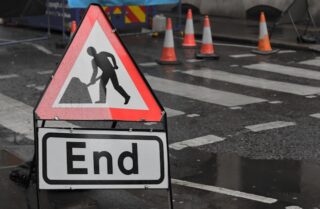 Highway construction signs are essential for ensuring the safety of motorists, pedestrians, and construction workers. These signs serve as advanced warnings, informing drivers about upcoming construction zones, lane closures, detours, and changes in road conditions. By providing clear and visible instructions, highway construction signs help drivers navigate through construction areas safely and efficiently, reducing the risk of accidents and traffic congestion.
Highway construction signs are essential for ensuring the safety of motorists, pedestrians, and construction workers. These signs serve as advanced warnings, informing drivers about upcoming construction zones, lane closures, detours, and changes in road conditions. By providing clear and visible instructions, highway construction signs help drivers navigate through construction areas safely and efficiently, reducing the risk of accidents and traffic congestion.
In addition, these signs play a crucial role in communicating important information to motorists, such as speed limit reductions, potential hazards, and the presence of construction vehicles and workers. Their presence is instrumental in maintaining order, minimizing disruptions, and promoting overall safety within construction zones, making them an indispensable component of road construction projects.
What Material is Highway Construction Signs made of?
They are made of durable and weather-resistant materials designed to withstand the rigors of outdoor use. Common materials used for these signs include aluminum and various types of retro-reflective sheeting. Anodized aluminum is favored for its lightweight yet tough characteristics, making it easy to install and transport while offering resistance to corrosion.
In addition, reflective sheeting materials such as engineering-grade, high-intensity, and diamond-grade prismatic sheeting are applied to enhance visibility, especially during nighttime or low-light conditions. These materials ensure that highway construction signs remain highly visible and legible, contributing to the overall safety and effectiveness of traffic control in construction zones.
What are the Types of Safety Signs used in Road Construction Zones?
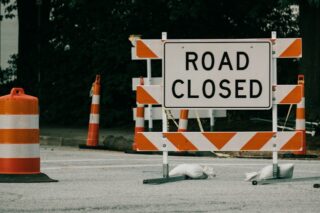 1. Warning Signs: These signs indicate hazardous areas or conditions, alerting individuals to potential dangers such as falling debris or excavation sites.
1. Warning Signs: These signs indicate hazardous areas or conditions, alerting individuals to potential dangers such as falling debris or excavation sites.
2. Prohibition Signs: These convey messages of restricted access or activities, such as “No authorized entry,” to ensure safety protocols are observed.
3. Mandatory Signs: These instruct individuals to adhere to specific requirements, such as wearing personal protective equipment (PPE) or reporting to the site office.
4. Personal Protection Signs: These emphasize the necessity of wearing safety gear, such as hard hats, boots, and high-visibility vests, to mitigate risks in construction areas.
What Color are Highway Construction Signs?
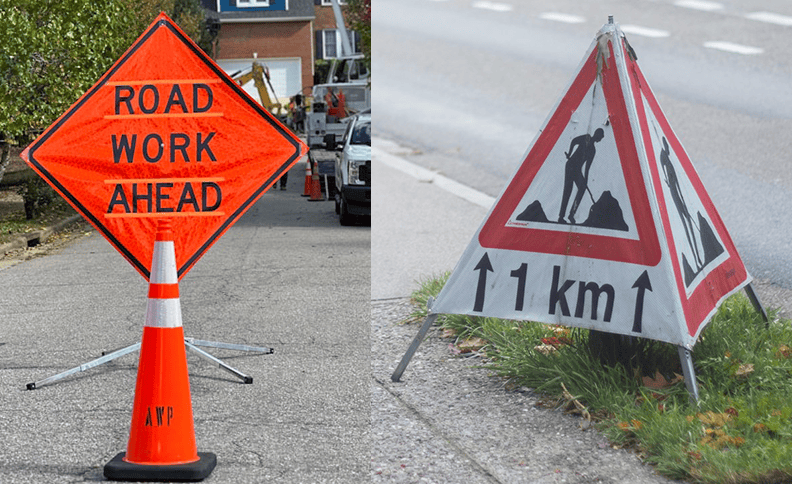
They are typically reflective orange with black copy and/or pictograms, and convey critical information to motorists and pedestrians. The most common colors used for highway construction signs are orange, fluorescent yellow-green, and white. Orange is always associated with construction and maintenance work, signaling caution and indicating the presence of construction activities or temporary traffic control measures.
Fluorescent yellow-green is utilized for warning signs to draw attention to potential hazards, while white is frequently used for regulatory and guide signs to provide clear instructions and information to road users. These distinct colors, coupled with reflective materials, ensure that highway construction signs are easily discernible, even in low-light conditions, contributing to enhanced safety and effective communication on roadways.
What Shapes are Highway Construction Signs?
They come in a variety of shapes, each serving a specific purpose to convey important information to drivers and pedestrians. The most common shapes for highway construction signs include rectangles and diamonds. Rectangular signs are often used for regulatory and guide signs, providing essential information such as speed limits, lane closures, and construction zone boundaries.
Diamond-shaped signs are typically reserved for warning signs, alerting road users to potential hazards, construction zones, or changes in road conditions. These shapes, coupled with bright colors and clear symbols, ensure that highway construction signs effectively communicate vital information to enhance safety and awareness on roadways.
Common Legends of Highway Construction Signs
1. “Road Construction”: This legend is commonly used to indicate the presence of ongoing construction activities or maintenance work on highways, alerting drivers to exercise caution and be prepared for potential hazards ahead.
2. “Detour”: The “Detour” legend is employed to redirect traffic away from the construction zone, providing alternative routes for drivers to navigate around the construction area.
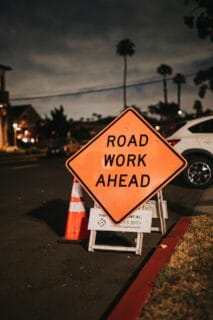 3. “Work Zone”: The “Work Zone” legend is utilized to signify the beginning of a designated area where construction or maintenance activities are taking place, prompting drivers to be vigilant and adhere to specific traffic control measures.
3. “Work Zone”: The “Work Zone” legend is utilized to signify the beginning of a designated area where construction or maintenance activities are taking place, prompting drivers to be vigilant and adhere to specific traffic control measures.
4. “Curve Ahead”: This legend is used to warn drivers of upcoming curves in the road, particularly in areas where construction activities may impact the normal flow of traffic.
5. “Flagman”: The “Flagman” legend is displayed to indicate the presence of a flagger or traffic controller at the construction site, signaling to drivers to be prepared to follow manual traffic guidance.
6. “No Passing Zone”: This legend is employed to designate areas within the construction zone where passing other vehicles is prohibited, ensuring safety and traffic flow control.
7. “Road Work Ahead”: The “Road Work Ahead” legend is commonly used to notify drivers of upcoming road construction or maintenance activities, prompting them to reduce speed and proceed with caution
These legends, often displayed in bold black text on vivid orange signs, play a crucial role in effectively communicating essential information to motorists, contributing to enhanced safety and awareness in highway construction zones.
Are Highway Construction Signs Required to be MUTCD-Compliant?
All highway and street signs are required to be MUTCD (Manual on Uniform Traffic Control Devices) compliant, as the MUTCD sets the standard for the design, application, and placement of traffic control devices, including signs, signals, and pavement markings, to ensure uniformity and consistency across the United States. Compliance with MUTCD guidelines is essential for highway construction signs to effectively convey information to road users, maintain safety, and minimize confusion.
Adhering to MUTCD standards ensures that construction signs feature appropriate colors, shapes, legends, and reflective materials, enabling drivers to quickly comprehend and respond to the information provided. By following MUTCD regulations, they may effectively contribute to the overall safety and efficiency of road traffic in construction zones.
Do Highway Construction Signs Need to be Reflective?
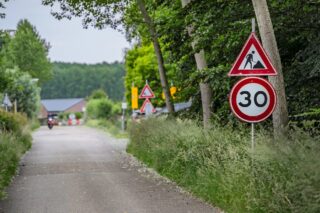 They are required to be reflective in order to enhance visibility and ensure their effectiveness, especially during low-light conditions or at night. Reflectivity is a crucial feature of construction signs, as it allows them to remain conspicuous and legible to drivers, even when illuminated by headlights or other light sources.
They are required to be reflective in order to enhance visibility and ensure their effectiveness, especially during low-light conditions or at night. Reflectivity is a crucial feature of construction signs, as it allows them to remain conspicuous and legible to drivers, even when illuminated by headlights or other light sources.
The reflective properties of these signs enable them to stand out against the surrounding environment, drawing attention to important messages and warnings related to construction zones, potential hazards, and traffic control measures. By being reflective, they significantly contribute to the safety of road users by providing clear and visible guidance, particularly in areas where construction activities may alter the normal flow of traffic or road conditions.
Conclusion
Highway construction signs communicate essential information to motorists and pedestrians, particularly in and around construction zones. These signs are designed to adhere to MUTCD standards, ensuring uniformity, visibility, and clarity in their messaging. From their distinct shapes to their reflective properties, they are meticulously made to alert road users to potential hazards, upcoming road conditions, and changes in traffic patterns. By employing a combination of vivid colors, bold legends, and standardized symbols, these signs effectively contribute to the safety and awareness of individuals navigating through construction areas, ultimately enhancing overall traffic control and reducing the risk of accidents.
Popular Posts:




